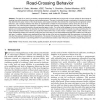Free Online Productivity Tools
i2Speak
i2Symbol
i2OCR
iTex2Img
iWeb2Print
iWeb2Shot
i2Type
iPdf2Split
iPdf2Merge
i2Bopomofo
i2Arabic
i2Style
i2Image
i2PDF
iLatex2Rtf
Sci2ools
TVCG
2011
2011
An Immersive Virtual Peer for Studying Social Influences on Child Cyclists' Road-Crossing Behavior
—The goal of our work is to develop a programmatically controlled peer to bicycle with a human subject for the purpose of studying how social interactions influence road-crossing behavior. The peer is controlled through a combination of reactive controllers that determine the gross motion of the virtual bicycle, action-based controllers that animate the virtual bicyclist and generate verbal behaviors, and a keyboard interface that allows an experimenter to initiate the virtual bicyclist’s actions during the course of an experiment. The virtual bicyclist’s repertoire of behaviors includes road following, riding alongside the human rider, stopping at intersections, and crossing intersections through specified gaps in traffic. The virtual cyclist engages the human subject through gaze, gesture, and verbal interactions. We describe the structure of the behavior code and report the results of a study examining how 10and 12-year-old children interact with a peer cyclist that makes eith...
Behavior | TVCG 2011 | Virtual | Virtual Bicyclist |
| Added | 15 May 2011 |
| Updated | 15 May 2011 |
| Type | Journal |
| Year | 2011 |
| Where | TVCG |
| Authors | Sabarish Babu, Timofey Grechkin, Benjamin Chihak, Christine Ziemer, Joseph K. Kearney, James F. Cremer, Jodie M. Plumert |
Comments (0)

